La lucha sigue: the struggle of the indignados continues
- July 27, 2011
People & Protest
The past three days in Madrid revealed a lot: the indignados are more organized than ever — and the authorities are growing increasingly fearful.
- Author
Puerta del Sol, Tuesday July 23-25th
“¡De norte a sur, de este a oeste, la lucha sigue, cueste lo que cueste!” From north to south, from east to west, the struggle goes on, whatever the cost — these words still ring through my head after three days of hearing them repeated over and over again by tens of thousands of determined protesters in Madrid.
This past weekend saw the largest mobilization of indignados in Spain since June 21. It turned out to be a decisive meeting for the future of the movement. Apart from the arrival of the marchas populares indignadas on Saturday and a major demonstration on Sunday, the 15-M movement held its very first Social Forum on Monday, bringing together indignants from all over Spain and Europe to discuss a series of unified demands and future actions.
Interestingly, the events revealed more than just the fact that the indignados are “still alive”, as some Spanish newspapers have put it. The reality is that they’re not just alive — they’re actually more organized than ever before. New ideas are rapidly being cooked up, and a number of spectacular actions are being planned for this fall. What’s more, the movement appears to be winning its PR battle against Spain’s and Europe’s political and economic elites.
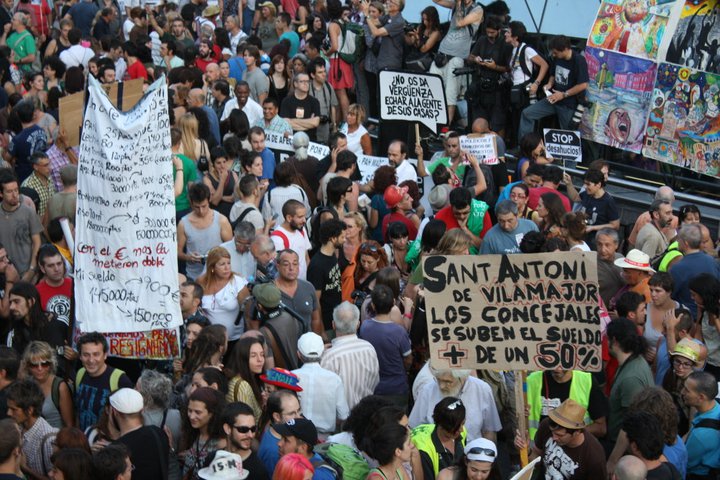 The good-spirited nature of the indignados and their constructive approach to anti-systemic protest has won them international media exposure and the sympathy of a vast majority of Spaniards. Not surprisingly, this relative success at the level of “hearts and minds” seems to be making Spanish authorities increasingly fearful of the likely ramifications that the movement will have on the legitimacy of the country’s traditional political establishment.
The good-spirited nature of the indignados and their constructive approach to anti-systemic protest has won them international media exposure and the sympathy of a vast majority of Spaniards. Not surprisingly, this relative success at the level of “hearts and minds” seems to be making Spanish authorities increasingly fearful of the likely ramifications that the movement will have on the legitimacy of the country’s traditional political establishment.
As the combined crew of EuropeanRevolution.net, TakeTheSquare.net and ROARMAG.org, we were in Madrid all weekend — talking to protesters and organizers in Retiro, taking notes, videos and pictures during the march from Atocha, shouting slogans at Parliament, and chatting the night away at Sol. What follows is our report on the incredibly inspiring events of the past three days, and the direction we expect the movement to go in the medium-term future.
Saturday July 23rd: the marchas arrive in Madrid
They had been walking for over a month, along six different routes from all over Spain, many of them crossing 400 kilometers or more. Some joined at relatively nearby places like Segovia, but others walked all the way from faraway Barcelona, Valencia or Cádiz. To a radical historian, it must almost have looked like a modern-day reincarnation of the revolutionary columns that marched from Barcelona to Madrid in 1936, at the peak of the Spanish civil war.
As our comrade Oscar reminded us on his excellent blog, the now legendary Columna Durruti sought to liberate the pueblos on the way to the capital. Similarly, the marchas populares indignadas sought to spread the word about the 15-M movement and rally support in the countryside. Moreover, the marches served as a way to include and give a voice to the people who would otherwise be excluded as a result of their geographic location.
Luckily there is no more civil war today and hence no more need for armed columns — allowing the marchas to take on a playful and joyous air. As we arrived in Parque Norte to welcome the walkers of the northern route and join meeting of the international commission, with representatives from France, Italy, Germany and Russia, we found a little peace festival on the move. Everywhere, people were making music, dancing, chatting, debating and painting banners.
There were at least a thousand of them. Their tents had been set up around a small pool, where a few dogs were happily frolicking in the water. A number of exhausted walkers were resting in the shade while the others enjoyed lunch — once again, a gift of solidarity from the locals. A large assembly was discussing what news and proposals should be relayed to the national assemblies scheduled over the weekend, while our smaller international meeting discussed ways to help the Spanish revolution go global.
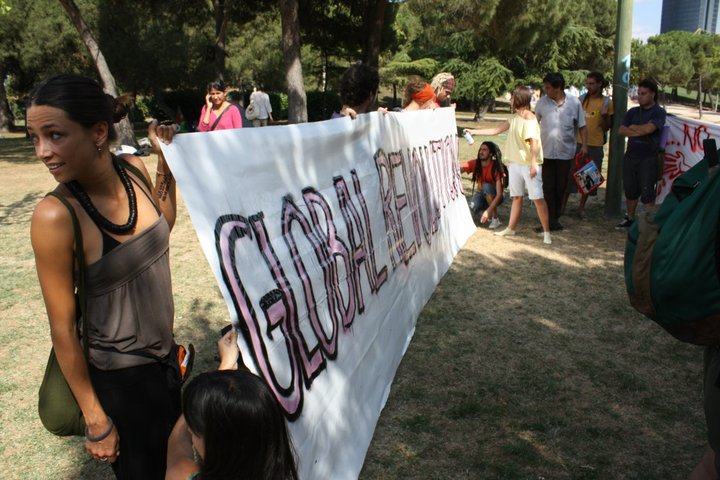 Around 19.00, we finally left the park and marched towards Puerta del Sol. The jovial last 8 kilometers were full of the indignant slogans that have by now become household expressions throughout Spain, like “¡el pueblo unido, jamás será vencido!”, “¡que no, que no, que no nos representan!”, and “¡a-anti-anti-capitalista!”. Despite the march blocking a major thoroughfare and sitting down in a number of intersections, many drivers-by honked their horns in appreciation.
Around 19.00, we finally left the park and marched towards Puerta del Sol. The jovial last 8 kilometers were full of the indignant slogans that have by now become household expressions throughout Spain, like “¡el pueblo unido, jamás será vencido!”, “¡que no, que no, que no nos representan!”, and “¡a-anti-anti-capitalista!”. Despite the march blocking a major thoroughfare and sitting down in a number of intersections, many drivers-by honked their horns in appreciation.
At 21.30, we arrived on Sol — the spiritual heart of the 15-M movement and Europe’s very own Tahrir Square. On our way in, we were greeted by a large banner that read “welcome dignity”. My anonymous Brazilian comrade and I ran ahead of the march and quickly scaled a high edifice to take some images and videos of the incoming marches. In a manner of minutes, tens of thousands converged upon the square from all six different entry routes.
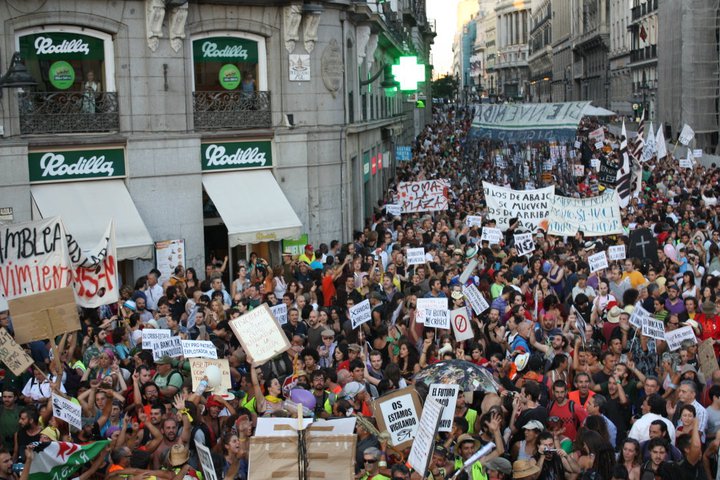 Observing this spectacle, imagining the delight, pride and happiness of the hundreds of marchers who had walked all the way from their home towns, and hearing the roaring applause from the crowds assembled in the square, I was honestly taken aback for a second. It was in that moment that I realized that whatever may happen to this movement in the future, it has already succeeded in shaking the very foundations of Spanish political culture and history in just as profound a way as May ’68 did to France.
Observing this spectacle, imagining the delight, pride and happiness of the hundreds of marchers who had walked all the way from their home towns, and hearing the roaring applause from the crowds assembled in the square, I was honestly taken aback for a second. It was in that moment that I realized that whatever may happen to this movement in the future, it has already succeeded in shaking the very foundations of Spanish political culture and history in just as profound a way as May ’68 did to France.
The scale of it all seems so unprecedented and the occupation tactics so innovative, that it’s hard to predict what the long-term impacts of the movement will be. But after witnessing the spontaneous self-organization of tens of thousands of human beings, without any form of central leadership, political representation or revolutionary vanguardism, I am now convinced that one thing is for sure: another world is possible.
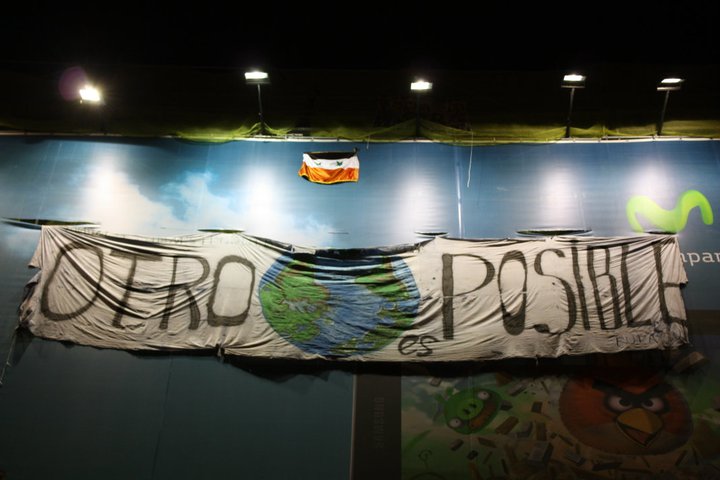 This fact was only confirmed when activists scaled the scaffolding of an historical building bordering on the square, cut out a part of the advertisement that had been hung up in front of it, and unfurled a huge banner saying “otro mundo es posible”, to deafening cheers from the crowd that had been assembled down below to observe the spectacle. And in fact, the other word is no longer just possible — it is being born right in front of our eyes.
This fact was only confirmed when activists scaled the scaffolding of an historical building bordering on the square, cut out a part of the advertisement that had been hung up in front of it, and unfurled a huge banner saying “otro mundo es posible”, to deafening cheers from the crowd that had been assembled down below to observe the spectacle. And in fact, the other word is no longer just possible — it is being born right in front of our eyes.
on Saturday night, a major popular assembly was held in the square, for the first time bringing together indignados from all over Spain. One of the highlights of the assemblea was a man telling the crowd that many of his colleagues colleagues supported the movement, but were too afraid to speak out in favor of it in public. After leaving people wondering for a while who his colleagues were, the man revealed that he was in fact a Madrid policeman. He rightly received a standing ovation from the crowds.
Sunday July 24th: large march from Atocha to Sol
Saturday night went on till late. We stayed in the square until at least 6 in the morning, chatting, joking and enjoying the pleasant atmosphere of the rebuilt Acampada del Sol. On Friday night already, a number of people had assembled in the square to rebuild the protest camp. In an impressive display of the sheer professionalism of the movement, a huge kitchen, TV/radio studio and internet/communications center were set up virtually overnight.
As I made my photo tour around the camp early Sunday morning, I was suddenly struck by a realization: in Madrid, the people have re-appropriated the public space and turned it into a genuine political free-state, virtually an autonomous commune at the heart of the extant capitalist state. No longer are critical ideas confined to the margins of society, to squats or eco-villages. Sol is the living proof that an alternative politics can flourish smack in the middle of this rotten system, and that a healthy new world can be born right within the old and sickly one.
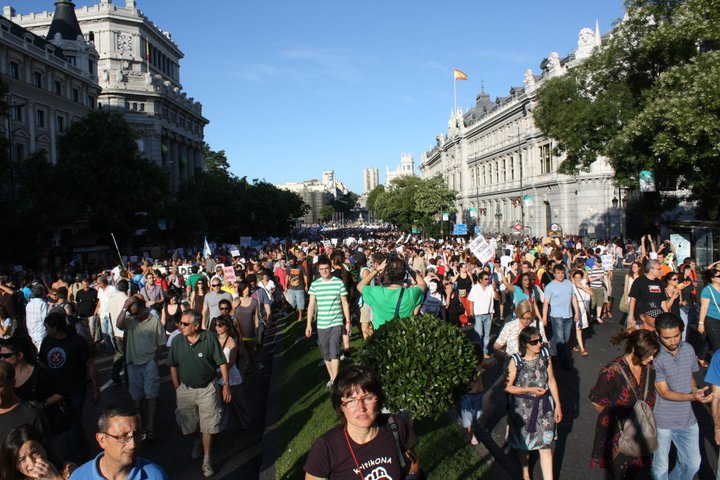 To be honest, I didn’t feel so great anymore after waking up sometime in the afternoon, though. Fairly hungover and exhausted by a persistent lack of sleep that we had been accruing since Athens, my Brazilian comrade and I stumbled our way to Atocha on Sunday to join the massive rally that had been planned for the day. But once I got there, all those petty physical concerns disappeared from my mind like they had never even existed.
To be honest, I didn’t feel so great anymore after waking up sometime in the afternoon, though. Fairly hungover and exhausted by a persistent lack of sleep that we had been accruing since Athens, my Brazilian comrade and I stumbled our way to Atocha on Sunday to join the massive rally that had been planned for the day. But once I got there, all those petty physical concerns disappeared from my mind like they had never even existed.
The moment we exited the metro we saw a genuine army of people assembled in front of the stately railway station. El País made a conservative estimation of 35.000+, although this the actual number is likely to be much higher. Even if you climbed on an elevation somewhere, you still couldn’t see the end of the march. There were simply people everywhere, and they were making an amount of noise I haven’t even heard in a football stadium.
As in Athens, I was immediately struck by the wide diversity of the people present. While many clueless reporters continue to refer to 15-M as a “youth movement”, nothing could be further from the truth: I’ve seen plenty of middle-aged Spaniards and retirees. Since no one carries any symbols or flags (apart from the Republican flag), the movement doesn’t allow itself be classified easily as a standard Leftist one, keeping it open for a wide range of participants.
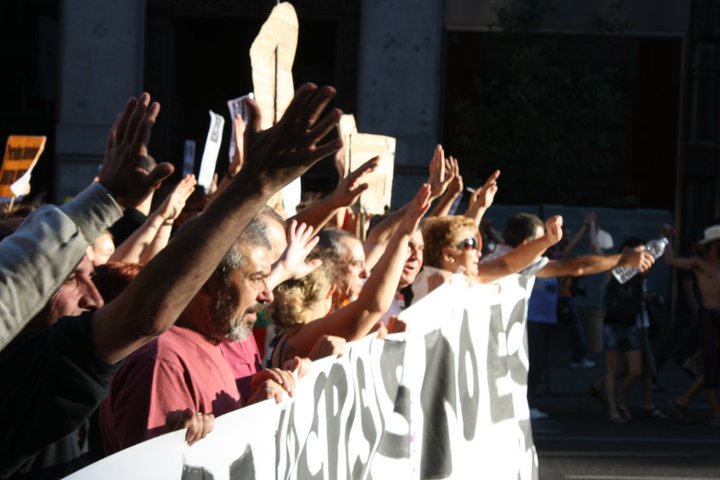 On our march, which left Atocha at 19.00 and arrived at Sol around 21.00, we passed by a number of key buildings, including the Ministry of Finance, the Bank of Spain and the heavily-guarded Congress buildings. Every single time, a small group of protesters would take off their clothes and dance in front of the police in a jovial gist of non-violent defiance. It’s exactly this playful and peaceful attitude that has earned the movement the endearment of so many.
On our march, which left Atocha at 19.00 and arrived at Sol around 21.00, we passed by a number of key buildings, including the Ministry of Finance, the Bank of Spain and the heavily-guarded Congress buildings. Every single time, a small group of protesters would take off their clothes and dance in front of the police in a jovial gist of non-violent defiance. It’s exactly this playful and peaceful attitude that has earned the movement the endearment of so many.
The only really naughty action came from a group of Barcelona squatters, who, after part of the march broke away from the pre-arranged route and charted their own path to Sol, drained their hands in red paint and splashed them all over a few banks along the way, so as to symbolize the blood on the hands of the financial sector in this crisis. The statement was particularly acute in light of this morning’s news that Catalonia will, in a near-homicidal austerity drive, close down some 40 health centers this year.
So logically, despite the “post-dogmatic” nature of the movement, its opposition to the capitalist system is overt: “¡no es una crisis, es el sistema!” was one of the key themes of Sunday’s protest. In the effort to bring out different social and ideological groups, it’s easy to forget about the common problems that unite us. One thing the indignados have made very clear from the start is that their resistance is not just to the economic crisis that has ravaged Spain, but to the global capitalist system which produced that crisis in the first place.
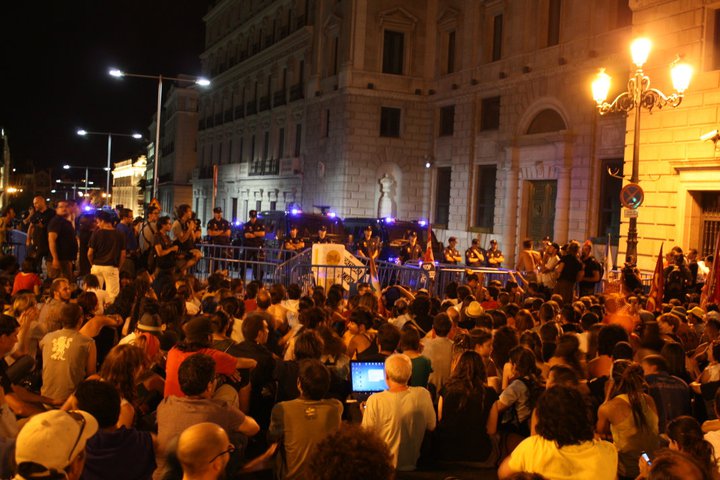 After the march arrived at Sol, a small group of maybe one thousand protesters, chanting “¡eso, eso, eso, vamos al congreso!”, went back to the Parliament building. There, they sat down in front of lines of riot police and chanted for hours, “¡a ti, a ti, a ti también te roban!” (they’re stealing from you as well), “¡no nos mires, únete!” (don’t just look at us, join us), and “¡si no nos dejan pasar, vamos a acapampar!” (if you don’t let us pass, we will camp out here).
After the march arrived at Sol, a small group of maybe one thousand protesters, chanting “¡eso, eso, eso, vamos al congreso!”, went back to the Parliament building. There, they sat down in front of lines of riot police and chanted for hours, “¡a ti, a ti, a ti también te roban!” (they’re stealing from you as well), “¡no nos mires, únete!” (don’t just look at us, join us), and “¡si no nos dejan pasar, vamos a acapampar!” (if you don’t let us pass, we will camp out here).
For a second, the situation got tense as the line of police suddenly stepped forward after one guy tried to climb the fence separating the two camps. In response, protesters surged forward en masse, keeping their hands up and chanting “¡estas son nuestras armas!” — these are our weapons. Eventually, most went back to Sol but a small group stayed and started a mini-encampment in front of Parliament, chanting: “¡eso, eso, eso, Acampada del Congreso!”
Monday July 25th: first 15-M social forum
While Monday was a quieter day than the previous two ones, it was in a way a much more important and constructive one, for it marked the first Social Forum hosted by the 15-M movement. In the beautiful Retiro Park, hundreds of indignados came together for a number of discussion groups on the economy, society, culture, international affairs, future actions, and other themes.
In a surprise move, Nobel Prize-winning economist Joseph Stiglitz even came by to air his solidarity with the movement and his hope that the indignados can contribute to constructive new ideas on the economy that will help overthrow the dominant neoliberal world order and its falsified ideas. He also expressed his hope that economic science could be united with social justice, and wished the protesters the best of luck in their difficult struggle.
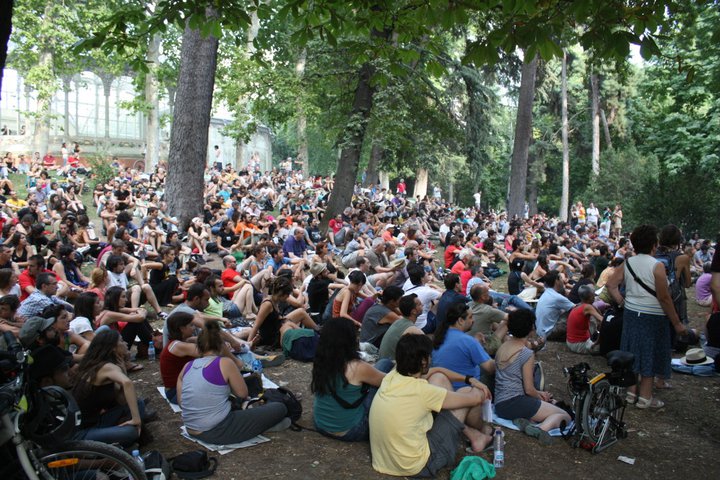 I arrived late because I spent most of the morning and early afternoon trying to upload the pictures of Saturday and Sunday’s protests. But when I arrived, I saw something special. In a small corner of the park, underneath the shade of the trees surrounding the Crystal Palace, hundreds of people were huddled together in different circles — large and small — debating the future of the movement, and, indeed, the future of our world.
I arrived late because I spent most of the morning and early afternoon trying to upload the pictures of Saturday and Sunday’s protests. But when I arrived, I saw something special. In a small corner of the park, underneath the shade of the trees surrounding the Crystal Palace, hundreds of people were huddled together in different circles — large and small — debating the future of the movement, and, indeed, the future of our world.
As I walked past the different groups to pick up on some of their discussions, I realized once again that we are in the early thralls of a fascinating transformation towards Democracy 2.0, in which decision-making is crowd-sourced horizontally in the public domain, and in which the people arrive at common solutions to common problems, through a decentralized, networked type of process. Each working group resembles a hive. Each of these hives, in turn, is embedded in a larger whole — the popular assembly.
This popular assembly, in turn, will itself become part of something even bigger. As the people here envision it, the revolution knows no borders. This is not a Spanish or even a European phenomenon — the 15-M model of spontaneous grassroots self-organization can be embedded within a global confederation of collectives or communes applying similar models developed by themselves. Praxis is demonstrating that such post-statism is no longer just dreaming at this stage — it’s already happening: through the Internet.
 The 15-M Social Forum in Retiro is, in a way, almost like a physical incarnation of the ‘spirit’ of the Internet. By connecting people, decentralizing power and democratizing the dissemination of information, both 15-M and the Web greatly empower the individual by embedding her within a highly versatile and resilient network. In both systems, the individual becomes at once less important and in the process, paradoxically, emerges from this process more empowered.
The 15-M Social Forum in Retiro is, in a way, almost like a physical incarnation of the ‘spirit’ of the Internet. By connecting people, decentralizing power and democratizing the dissemination of information, both 15-M and the Web greatly empower the individual by embedding her within a highly versatile and resilient network. In both systems, the individual becomes at once less important and in the process, paradoxically, emerges from this process more empowered.
This direct, participatory model of “real democracy” is clearly a radical departure from the principle of representative democracy that has dominated our liberal society for the past three or four centuries. For the indignados, it’s the very underpinning of their political philosophy. A transformation to real democracy will be the starting-point of a new system beyond the excessive power of finance capital and the destructive forces of political corruption.
Even if these ideas prove to be Utopian and unworkable in practice, it’s exactly this type of open dialogue that we should be having at this stage. In this profound moment of crisis, we need to talk to each other like fully equal human beings. As such, our collective discourse cannot be limited to the superficial debates within a privileged class of political representatives or economic experts. Instead, we need a dialogue between real people.
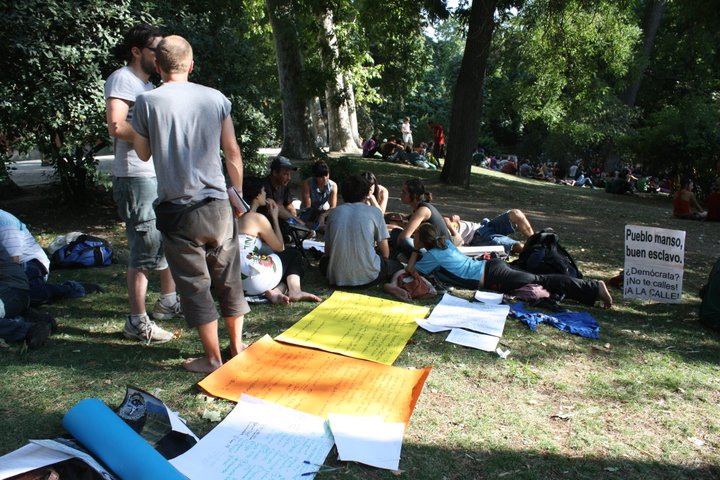 What we need, in other words, and what the 15-M movement has so importantly achieved to do, is to recreate the the public sphere — the demise of which was so famously lamented by the German philosopher Juergen Habermas. In this public sphere, anyone can have a say, and anyone has the power to impact the eventual decisions being made within the assemblies. Here in Retiro, we are learning that our collective mind is infinitely greater than the petty minds of individuals. In a way, it’s the death of the Modern Ego.
What we need, in other words, and what the 15-M movement has so importantly achieved to do, is to recreate the the public sphere — the demise of which was so famously lamented by the German philosopher Juergen Habermas. In this public sphere, anyone can have a say, and anyone has the power to impact the eventual decisions being made within the assemblies. Here in Retiro, we are learning that our collective mind is infinitely greater than the petty minds of individuals. In a way, it’s the death of the Modern Ego.
It must be said, of course, that there is one major disadvantage to this form of organization: it can be tediously slow. As my Brazilian friend told me, it was probably good that I came late, since the start of the day was mostly made up of repetitive talk that never seemed to go anywhere. But, interestingly, as the day came to a close, concrete suggestions did emerge from the various working groups, and there is a fairly clear image now of where the movement will be headed in the months to come.
The struggle continues
Over the next two months, the indignados will enter into an extensive dialogue between themselves and similar movements around Europe in the attempt to come up with a single document that expresses the demands of the European indignés. Key points include taming the out-of-control financial sector, finding a sustainable solution to the debt problem, fighting political corruption and tax evasion, pursuing more investment in education and health, and making a serious move towards participatory democracy.
To give extra power to these demands, which are still to be concretized and verbalized over the coming month or so, 15-M is planning a European and global day of action on October 15th. Yesterday already, a small group of indignados left Puerta del Sol to start an epic march towards Brussels. They will be joined by thousands in Paris, and will eventually congrate with the indignés of Europe in Brussels for a week-long Social Forum and a major demonstration on the 15th.
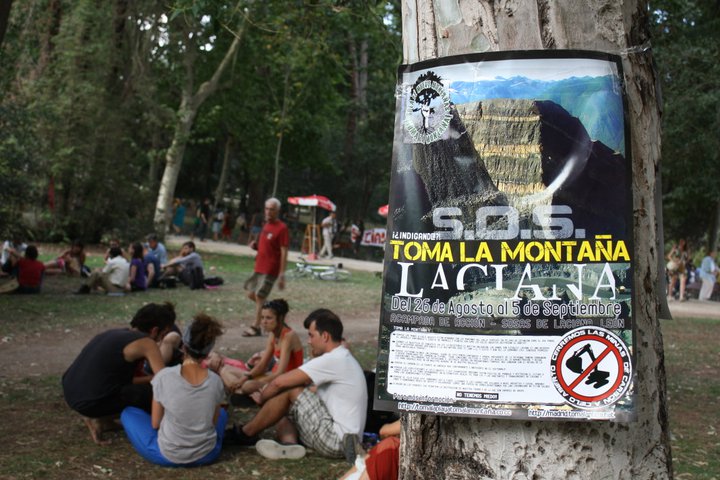 In the meantime, coordination within Spain will continue for a number of innovative new local actions, like Toma la Montaña, an attempt to occupy a mountain that is being destroyed by a huge coal mine. Another thing the indignados will continue to do is to try and prevent house foreclosures of crisis-stricken families through peaceful civic disobedience, often by occupying a house with dozens of activists and chaining themselves to walls and fences.
In the meantime, coordination within Spain will continue for a number of innovative new local actions, like Toma la Montaña, an attempt to occupy a mountain that is being destroyed by a huge coal mine. Another thing the indignados will continue to do is to try and prevent house foreclosures of crisis-stricken families through peaceful civic disobedience, often by occupying a house with dozens of activists and chaining themselves to walls and fences.
Finally, one of the crucial tests for the movement will be whether it can come up with a coherent political and economic manifesto that outlines how exactly it plans to deal with the current capitalist crisis in a decisive and sustainable way. But before we judge them on that, let’s first remember the enormous achievements that this baby movement has been able to put to its name in just two-and-a-half months’ time.
As the deployment of excessive amounts of police in front of Parliament demonstrated, the Spanish authorities are growing increasingly fearful of the indignados. Not because they will storm Parliament and overthrow the government through use of force — violence has been virtually non-existent since the start of the movement — but rather because the protesters are managing to break something far more precious than shop windows or police cars: they are breaking the waning popular consent that undergirds the fragile legitimacy of Spain’s ruling elite.
 Ever since the police violence in Barcelona backfired and boosted the numbers of sympathizers with the movement, Spanish authorities have been very wary of provoking the indignados. Out of fear of breaking Spain’s fragile social peace and delegitimizing the government in the eyes of the people, the forces of the state have been kept at bay, leaving the indignados free to wage their relentlessly peaceful struggle for a real democracy.
Ever since the police violence in Barcelona backfired and boosted the numbers of sympathizers with the movement, Spanish authorities have been very wary of provoking the indignados. Out of fear of breaking Spain’s fragile social peace and delegitimizing the government in the eyes of the people, the forces of the state have been kept at bay, leaving the indignados free to wage their relentlessly peaceful struggle for a real democracy.
In the process, 15-M is gradually undermining the position of the ruling classes through the erosion of popular consent. It is here that the main power of the movement resides. The cultural and political hegemony of Spain’s ruling elite hasn’t been under such immense pressure from civil society since the days of Franco. Do not underestimate the power of the people. We are only just getting started.
Source URL — https://roarmag.org/essays/indignados-struggle-goes-on/

